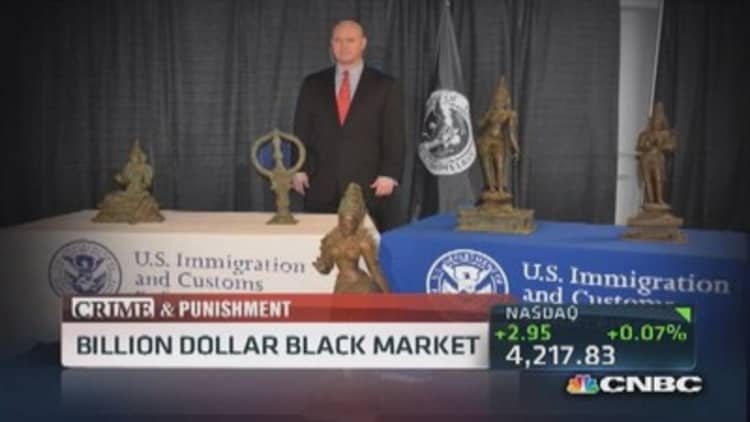
The case reads like an "Indiana Jones" movie script. A New York City antiquities dealer raids archaeological sites and temples in India, Pakistan and Cambodia, and then smuggles the pieces into the United States, where they're sold for millions of dollars.
According to federal authorities, that's exactly what Subhash Kapoor did. The 64-year-old Kapoor is accused of stealing hundreds of pieces of art valued at more than $100 million, according to James Dinkins, a director of Homeland Security Investigations. That department is overseeing the case involving one of the largest art rings. "This is definitely one of the biggest, I think that we've seen in the world," Dinkins told CNBC.
Dinkins also described how Kapoor's team allegedly targeted sacred sites.
"These areas are very remote. They go in under the cover of darkness with trucks and tools, and sometimes it's actually during the excavation process itself, when they're discovering them, before the world even knows they found them," Dinkins told CNBC.
"They'll excavate them out and leave under the cover of darkness, conceal it on trucks, move it around to ports of entry, and ship it around the world."
One stolen sculpture, a rare second century sandstone of a woman, is said to be worth $15 million, according to investigators. A 1,700-pound statue of Buddha's head from the first-second century is worth $4.5 million, and an 11th century Uma bronze statue $2.5 million, according to authorities. Indian officials, however, refuse to put a price tag on what they consider to be priceless, national treasures.
A spokesperson for Kapoor did not respond to emailed requests for comment.
Kapoor is not a newcomer to the art world.
He opened a gallery in New York City, Art of the Past, in 1974. For decades, he sold legitimate pieces right next to stolen items, authorities said. Several stolen pieces found their way into museums around the world. One stolen $5 million item was displayed in the National Gallery in Australia. Kapoor also sold and donated numerous pieces to the Metropolitan Museum of Art in New York. The museum's website lists some of the drawings as a, "Gift of Subhash Kapoor, in memory of his parents, Smt Shashi Kanta and Shree Parshotam Ram Kapoor."
A Metropolitan Museum of Art official told CNBC, "The Metropolitan received a number of gifts over the years from Mr. Kapoor, and also made some purchases—and we are currently engaged in researching the ownership histories of all of them."
The National Gallery in Australia said in a statement that it owns 21 pieces of art from Kapoor's gallery collected between 2002 and 2011 and that it will cooperate with relevant authorities.
More museums around the world are believed to house art stolen form Kapoor, authorities say.
(Read more: Ex-cops, firemen face charges in disability scam)
It all started to unravel for Kapoor beginning in 2012 with several raids. Authorities at one point intercepted a package at Newark International Airport. The package contained a stolen statue on its way to Kapoor in New York City, authorities said. Homeland Security Investigations, or HSI, closed in and raided Art of the Past and several storage facilities in New York City. Authorities confiscated nearly $100 million in antiquities.
"We've gone into businesses and taken them off walls, the lobbies where they are displaying them. And sometimes it's even professional athletes and entertainers who have a lot of wealth and money and can afford to spend a million dollars to display an item in their home," Dinkins told CNBC.
Authorities including Shawn Bray, director of Interpol Washington, acknowledge that policing international fraud rings is incredibly difficult. "If you take a look at the Interpol database, there are of 42,000 items there. When you add up a value that you could possibly give these things, the price is staggering," Bray said. Authorities estimate several billion dollars exchange hands in the illicit antiquities market each year.
Several pieces of additional stolen Indian art—not attached to the Kapoor case—were returned this week to the Indian Consulate. Consul General Dnyaneshwar M. Mulay told CNBC about the importance of getting these national treasures back to India.
"Whatever their market value, they are invaluable historically, culturally. So that they are going back is a matter of pride and joy for our relationship," Mulay said. "It is very unfortunate that there are still people that think it is required to be taken out, stolen, smuggled in the international market. The problem is there are buyers and sellers. And both sides, the supply side and the demand side, need to be constrained, controlled, and very probable treated by the law," Mulay said.
Kapoor was apprehended by Interpol in Germany and extradited to India, where he's being held on charges of trafficking in precious idols.
—By CNBC's Jeff Pohlman. Foll the team at @CNBCInvestigate.

